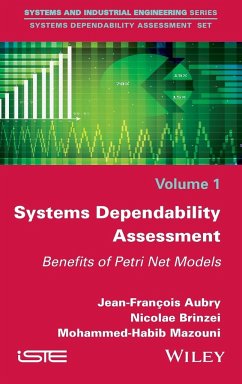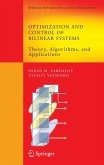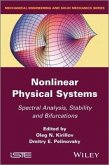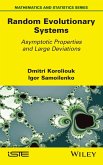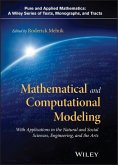Jean-Francois Aubry, Nicolae Brinzei, Mohammed-Habib Mazouni
Systems Dependability Assessment
Benefits of Petri Net Models
Jean-Francois Aubry, Nicolae Brinzei, Mohammed-Habib Mazouni
Systems Dependability Assessment
Benefits of Petri Net Models
- Gebundenes Buch
- Merkliste
- Auf die Merkliste
- Bewerten Bewerten
- Teilen
- Produkt teilen
- Produkterinnerung
- Produkterinnerung
Petri Nets were defined for the study of discrete events systems and later extended for many purposes including dependability assessment. In our knowledge, no book deals specifically with the use of different type of PN to dependability. We propose in addition to bring a focus on the adequacy of Petri net types to the study of various problems related to dependability such as risk analysis and probabilistic assessment. In the first part, the basic models of PN and some useful extensions are briefly recalled. In the second part, the PN are used as a formal model to describe the evolution…mehr
Andere Kunden interessierten sich auch für
![Several Essays in Political Arithmetick Several Essays in Political Arithmetick]() William PettySeveral Essays in Political Arithmetick42,99 €
William PettySeveral Essays in Political Arithmetick42,99 €![Economics and Mathematical Modeling in Health-Related Research Economics and Mathematical Modeling in Health-Related Research]() Economics and Mathematical Modeling in Health-Related Research163,99 €
Economics and Mathematical Modeling in Health-Related Research163,99 €![Optimization and Control of Bilinear Systems Optimization and Control of Bilinear Systems]() Panos M PardalosOptimization and Control of Bilinear Systems75,99 €
Panos M PardalosOptimization and Control of Bilinear Systems75,99 €![Nonlinear Physical Systems Nonlinear Physical Systems]() Oleg N KirillovNonlinear Physical Systems225,99 €
Oleg N KirillovNonlinear Physical Systems225,99 €![Random Evolutionary Systems Random Evolutionary Systems]() Dmitri KorolioukRandom Evolutionary Systems187,99 €
Dmitri KorolioukRandom Evolutionary Systems187,99 €![Mathematical Modelling Mathematical Modelling]() Seyed M MoghadasMathematical Modelling120,99 €
Seyed M MoghadasMathematical Modelling120,99 €![Mathematical and Computational Modeling Mathematical and Computational Modeling]() Mathematical and Computational Modeling118,99 €
Mathematical and Computational Modeling118,99 €-
-
-
Petri Nets were defined for the study of discrete events systems and later extended for many purposes including dependability assessment. In our knowledge, no book deals specifically with the use of different type of PN to dependability. We propose in addition to bring a focus on the adequacy of Petri net types to the study of various problems related to dependability such as risk analysis and probabilistic assessment. In the first part, the basic models of PN and some useful extensions are briefly recalled. In the second part, the PN are used as a formal model to describe the evolution process of critical system in the frame of an ontological approach. The third part focuses on the stochastic Petri Nets (SPN) and their use in dependability assessment. Different formal models of SPN are formally presented (semantics, evolution rules...) and their equivalence with the corresponding class of Markov processes to get an analytical assessment of dependability. Simplification methods are proposed in order to reduce the size of analytical model and to make it more calculable. The introduction of some concepts specific to high level PN allows too the consideration of complex systems. Few applications in the field of the instrumentation and control (l&C) systems, safety integrated systems (SIS) emphasize the benefits of SPN for dependability assessment.
Hinweis: Dieser Artikel kann nur an eine deutsche Lieferadresse ausgeliefert werden.
Hinweis: Dieser Artikel kann nur an eine deutsche Lieferadresse ausgeliefert werden.
Produktdetails
- Produktdetails
- Verlag: Wiley
- Seitenzahl: 288
- Erscheinungstermin: 23. Februar 2016
- Englisch
- Abmessung: 240mm x 161mm x 20mm
- Gewicht: 595g
- ISBN-13: 9781848219915
- ISBN-10: 1848219911
- Artikelnr.: 44217305
- Herstellerkennzeichnung
- Libri GmbH
- Europaallee 1
- 36244 Bad Hersfeld
- gpsr@libri.de
- Verlag: Wiley
- Seitenzahl: 288
- Erscheinungstermin: 23. Februar 2016
- Englisch
- Abmessung: 240mm x 161mm x 20mm
- Gewicht: 595g
- ISBN-13: 9781848219915
- ISBN-10: 1848219911
- Artikelnr.: 44217305
- Herstellerkennzeichnung
- Libri GmbH
- Europaallee 1
- 36244 Bad Hersfeld
- gpsr@libri.de
Pr. Dr. Jean-Francois AUBRY, Professor Emeritus, University of Lorraine, France. Dr. Nicolae BRINZEI, Associate University of Lorraine. Dr. Mohammed-Habib MAZOUNI, Engineer.
Introduction xi
Part 1 Short Review of Petri Net Modeling 1
Introduction to Part 1 3
Chapter 1 Autonomous Petri Nets 5
1.1 Unmarked Petri nets 5
1.1.1 Definitions 5
1.1.2 Drawing 6
1.1.3 Other definitions 7
1.2 Marking of a PN 7
1.2.1 Order relation on markings 8
1.2.2 Enabled transition 9
1.3 Dynamics of autonomous PNs 9
1.3.1 Firing of a transition 9
1.3.2 Transition matrix 11
1.3.3 Firing sequence 11
1.3.4 Reachable marking 12
1.3.5 Fundamental equation 12
1.3.6 Properties of PN 14
1.3.7 Other properties 14
1.3.8 Invariants in a PN 15
1.3.9 Reachability graph 16
Chapter 2 Petri Nets and Event Languages 19
2.1 Labeled PNs 19
2.1.1 Formal definition 19
2.1.2 Generated and marked languages 20
2.2 Example 21
Chapter 3 Comparison Petri Nets -
Finite State Automaton 25
3.1 Language expression 26
3.2 Building of the models 27
3.2.1 Synchronization of submodels 28
3.2.2 Resource sharing 29
3.2.3 Construction by refinement 30
3.3 Compactness of the model 32
Chapter 4 Some Extensions of Petri Nets 35
4.1 PN with inhibitor arcs 35
4.2 Timed PN 36
4.2.1 P-timed Petri nets 37
4.2.2 T-timed Petri nets 37
4.3 Synchronized PN 38
4.4 Timed synchronized PN 40
4.5 Interpreted PN 41
4.6 Colored PN 42
4.6.1 Introduction example 42
4.6.2 Formal definition 45
4.6.3 A dedicated software CPN Tools 46
Conclusion to Part 1 51
Part 2 A Formal Approach to Risk Assessment 53
Introduction to Part 2 51
Chapter 5 Ontology-based Accidental Process 61
5.1 Preliminary definitions 61
5.2 Elementary entities: HSE and VTE 63
5.2.1 Hazard supplier entity (HSE) 63
5.2.2 Vulnerable target entity (VTE) 63
5.3 Elementary situations and elementary events 64
5.3.1 State versus situation 64
5.3.2 Initial situation (IS) 64
5.3.3 Initiating event (IEv) 64
5.3.4 Hazard situation (HS) 65
5.3.5 Exposure event (EEv) 65
5.3.6 Exposure situation (ES) 65
5.3.7 Accident situation 65
5.3.8 Hazardous (feared) event (HEv) 65
5.4 Conclusion 66
Chapter 6 Petri Net Modeling of the
Accidental Process 67
6.1 Elementary process 68
6.2 Sequence of elementary processes 71
6.3 Modeling the action of a safety barrier 71
6.4 Modeling of a cumulative process 73
6.5 PN as a support for risk assessment 75
6.5.1 Modeling of the damage 75
6.5.2 Modeling of the event frequencies 75
6.5.3 CPN Tools implementation 77
6.5.4 Evaluation rule of the risk 83
6.6 Conclusion 86
Chapter 7 Illustrative Example 87
7.1 Functional description 87
7.2 Building of an accidental process 88
7.2.1 First elementary process 88
7.2.2 Second elementary process 91
7.2.3 Parallel process 92
7.2.4 The whole model 92
7.3 Conclusion 94
Chapter 8 Design and Safety Assessment Cycle 95
8.1 Five essential steps 95
8.2 Ontological interest 98
Conclusion to Part 2 101
Part 3 Stochastic Petri Nets 103
Introduction to Part 3 105
Chapter 9 Basic Concept 107
9.1 Introductory example 107
9.2 Formal definition 108
Chapter 10 Semantics, Properties and
Evolution Rules of an SPN 111
10.1 Conservatism properties 112
10.1.1 Conservatism of the mean marking in steady state 112
10.1.2 Conservatism of the flow in steady state 113
10.2 Mean sojourn time in a place of a SPN 113
10.3 Equivalent Markov process 114
10.4 Example of SPN for systems dependability modelling and assessment 116
Chapter 11 Simplification of Complex Models 121
11.1 Introduction 121
11.2 System modeling 122
11.3 Presentation of the quantitative analysis method 124
11.3.1 Steps to obtain an aggregated Markov graph 124
11.3.2 Toward a direct establishment of a reduced Markov graph 137
11.4 Example 137
11.4.1 Failure modeling 138
11.4.2 Study of the different functional and hardware solutions 139
11.4.3 Evaluation of the weighting coefficients from the Petri nets 144
11.4.4 Conclusion 147
Chapter 12 Extensions of SPN 149
12.1 Introduction 149
12.2 Relationship between stochastic Petri nets and stochastic processes
150
12.3 The transition firing policy 151
12.4 Associated stochastic processes 151
12.4.1 Temporal memory based on resampling 152
12.4.2 Temporal memory based on age memory or on enabling memory 153
12.4.3 Stochastic process underlying a stochastic PN 154
12.4.4 Embedded Markov chain of the stochastic process 157
12.4.5 Application to a case study 159
12.5 Synchronization problem in generalized stochastic Petri nets 162
12.5.1 GSPN with internal synchronization 162
12.5.2 SPN with predicates and assertions 164
12.6 Conclusion 168
Part 4 Applications of Stochastic Petri Nets to Assessment Problems in
Industrial Systems 169
Introduction to Part 4 171
Chapter 13 Application in Dynamic Reliability 175
13.1 Presentation of the system and hypothesis 175
13.2 System modeling with Petri net 177
13.3 Methodology application 179
13.4 Construction of an aggregated Markov graph 180
13.5 Conclusion 185
Chapter 14 Classical Dependability Assessment 187
14.1 Availability study of a nuclear power plant subsystem 187
14.1.1 CPN modeling 188
14.1.2 Reliability and dependability assessment 192
14.1.3 Conclusion 196
14.2 Common causes failures in nuclear plants (safety oriented) 197
14.2.1 The Atwood model 197
14.2.2 Case study 199
14.2.3 Probabilistic dependability assessment 208
14.2.4 Conclusion 212
Chapter 15 Impact of Failures on System Performances 213
15.1 Reliability evaluation of networked control system 213
15.1.1 Statement of the problem 213
15.1.2 Reliability criteria of an NCS 215
15.1.3 Elements of modeling 216
15.1.4 Simulation and results 225
15.1.5 Evaluation of reliability 230
15.1.6 Conclusion 230
15.2 Railway signaling 231
15.2.1 Introduction 231
15.2.2 Interest 233
15.2.3 Signaling system specifications 234
15.2.4 Elements to be modeled 235
15.2.5 Architecture of the model 236
15.2.6 Example of an elementary model 237
15.2.7 Incident generation 239
15.2.8 Results 239
15.2.9 Conclusion 242
Conclusion 245
Appendix 247
Bibliography 251
Index 261
Part 1 Short Review of Petri Net Modeling 1
Introduction to Part 1 3
Chapter 1 Autonomous Petri Nets 5
1.1 Unmarked Petri nets 5
1.1.1 Definitions 5
1.1.2 Drawing 6
1.1.3 Other definitions 7
1.2 Marking of a PN 7
1.2.1 Order relation on markings 8
1.2.2 Enabled transition 9
1.3 Dynamics of autonomous PNs 9
1.3.1 Firing of a transition 9
1.3.2 Transition matrix 11
1.3.3 Firing sequence 11
1.3.4 Reachable marking 12
1.3.5 Fundamental equation 12
1.3.6 Properties of PN 14
1.3.7 Other properties 14
1.3.8 Invariants in a PN 15
1.3.9 Reachability graph 16
Chapter 2 Petri Nets and Event Languages 19
2.1 Labeled PNs 19
2.1.1 Formal definition 19
2.1.2 Generated and marked languages 20
2.2 Example 21
Chapter 3 Comparison Petri Nets -
Finite State Automaton 25
3.1 Language expression 26
3.2 Building of the models 27
3.2.1 Synchronization of submodels 28
3.2.2 Resource sharing 29
3.2.3 Construction by refinement 30
3.3 Compactness of the model 32
Chapter 4 Some Extensions of Petri Nets 35
4.1 PN with inhibitor arcs 35
4.2 Timed PN 36
4.2.1 P-timed Petri nets 37
4.2.2 T-timed Petri nets 37
4.3 Synchronized PN 38
4.4 Timed synchronized PN 40
4.5 Interpreted PN 41
4.6 Colored PN 42
4.6.1 Introduction example 42
4.6.2 Formal definition 45
4.6.3 A dedicated software CPN Tools 46
Conclusion to Part 1 51
Part 2 A Formal Approach to Risk Assessment 53
Introduction to Part 2 51
Chapter 5 Ontology-based Accidental Process 61
5.1 Preliminary definitions 61
5.2 Elementary entities: HSE and VTE 63
5.2.1 Hazard supplier entity (HSE) 63
5.2.2 Vulnerable target entity (VTE) 63
5.3 Elementary situations and elementary events 64
5.3.1 State versus situation 64
5.3.2 Initial situation (IS) 64
5.3.3 Initiating event (IEv) 64
5.3.4 Hazard situation (HS) 65
5.3.5 Exposure event (EEv) 65
5.3.6 Exposure situation (ES) 65
5.3.7 Accident situation 65
5.3.8 Hazardous (feared) event (HEv) 65
5.4 Conclusion 66
Chapter 6 Petri Net Modeling of the
Accidental Process 67
6.1 Elementary process 68
6.2 Sequence of elementary processes 71
6.3 Modeling the action of a safety barrier 71
6.4 Modeling of a cumulative process 73
6.5 PN as a support for risk assessment 75
6.5.1 Modeling of the damage 75
6.5.2 Modeling of the event frequencies 75
6.5.3 CPN Tools implementation 77
6.5.4 Evaluation rule of the risk 83
6.6 Conclusion 86
Chapter 7 Illustrative Example 87
7.1 Functional description 87
7.2 Building of an accidental process 88
7.2.1 First elementary process 88
7.2.2 Second elementary process 91
7.2.3 Parallel process 92
7.2.4 The whole model 92
7.3 Conclusion 94
Chapter 8 Design and Safety Assessment Cycle 95
8.1 Five essential steps 95
8.2 Ontological interest 98
Conclusion to Part 2 101
Part 3 Stochastic Petri Nets 103
Introduction to Part 3 105
Chapter 9 Basic Concept 107
9.1 Introductory example 107
9.2 Formal definition 108
Chapter 10 Semantics, Properties and
Evolution Rules of an SPN 111
10.1 Conservatism properties 112
10.1.1 Conservatism of the mean marking in steady state 112
10.1.2 Conservatism of the flow in steady state 113
10.2 Mean sojourn time in a place of a SPN 113
10.3 Equivalent Markov process 114
10.4 Example of SPN for systems dependability modelling and assessment 116
Chapter 11 Simplification of Complex Models 121
11.1 Introduction 121
11.2 System modeling 122
11.3 Presentation of the quantitative analysis method 124
11.3.1 Steps to obtain an aggregated Markov graph 124
11.3.2 Toward a direct establishment of a reduced Markov graph 137
11.4 Example 137
11.4.1 Failure modeling 138
11.4.2 Study of the different functional and hardware solutions 139
11.4.3 Evaluation of the weighting coefficients from the Petri nets 144
11.4.4 Conclusion 147
Chapter 12 Extensions of SPN 149
12.1 Introduction 149
12.2 Relationship between stochastic Petri nets and stochastic processes
150
12.3 The transition firing policy 151
12.4 Associated stochastic processes 151
12.4.1 Temporal memory based on resampling 152
12.4.2 Temporal memory based on age memory or on enabling memory 153
12.4.3 Stochastic process underlying a stochastic PN 154
12.4.4 Embedded Markov chain of the stochastic process 157
12.4.5 Application to a case study 159
12.5 Synchronization problem in generalized stochastic Petri nets 162
12.5.1 GSPN with internal synchronization 162
12.5.2 SPN with predicates and assertions 164
12.6 Conclusion 168
Part 4 Applications of Stochastic Petri Nets to Assessment Problems in
Industrial Systems 169
Introduction to Part 4 171
Chapter 13 Application in Dynamic Reliability 175
13.1 Presentation of the system and hypothesis 175
13.2 System modeling with Petri net 177
13.3 Methodology application 179
13.4 Construction of an aggregated Markov graph 180
13.5 Conclusion 185
Chapter 14 Classical Dependability Assessment 187
14.1 Availability study of a nuclear power plant subsystem 187
14.1.1 CPN modeling 188
14.1.2 Reliability and dependability assessment 192
14.1.3 Conclusion 196
14.2 Common causes failures in nuclear plants (safety oriented) 197
14.2.1 The Atwood model 197
14.2.2 Case study 199
14.2.3 Probabilistic dependability assessment 208
14.2.4 Conclusion 212
Chapter 15 Impact of Failures on System Performances 213
15.1 Reliability evaluation of networked control system 213
15.1.1 Statement of the problem 213
15.1.2 Reliability criteria of an NCS 215
15.1.3 Elements of modeling 216
15.1.4 Simulation and results 225
15.1.5 Evaluation of reliability 230
15.1.6 Conclusion 230
15.2 Railway signaling 231
15.2.1 Introduction 231
15.2.2 Interest 233
15.2.3 Signaling system specifications 234
15.2.4 Elements to be modeled 235
15.2.5 Architecture of the model 236
15.2.6 Example of an elementary model 237
15.2.7 Incident generation 239
15.2.8 Results 239
15.2.9 Conclusion 242
Conclusion 245
Appendix 247
Bibliography 251
Index 261
Introduction xi
Part 1 Short Review of Petri Net Modeling 1
Introduction to Part 1 3
Chapter 1 Autonomous Petri Nets 5
1.1 Unmarked Petri nets 5
1.1.1 Definitions 5
1.1.2 Drawing 6
1.1.3 Other definitions 7
1.2 Marking of a PN 7
1.2.1 Order relation on markings 8
1.2.2 Enabled transition 9
1.3 Dynamics of autonomous PNs 9
1.3.1 Firing of a transition 9
1.3.2 Transition matrix 11
1.3.3 Firing sequence 11
1.3.4 Reachable marking 12
1.3.5 Fundamental equation 12
1.3.6 Properties of PN 14
1.3.7 Other properties 14
1.3.8 Invariants in a PN 15
1.3.9 Reachability graph 16
Chapter 2 Petri Nets and Event Languages 19
2.1 Labeled PNs 19
2.1.1 Formal definition 19
2.1.2 Generated and marked languages 20
2.2 Example 21
Chapter 3 Comparison Petri Nets -
Finite State Automaton 25
3.1 Language expression 26
3.2 Building of the models 27
3.2.1 Synchronization of submodels 28
3.2.2 Resource sharing 29
3.2.3 Construction by refinement 30
3.3 Compactness of the model 32
Chapter 4 Some Extensions of Petri Nets 35
4.1 PN with inhibitor arcs 35
4.2 Timed PN 36
4.2.1 P-timed Petri nets 37
4.2.2 T-timed Petri nets 37
4.3 Synchronized PN 38
4.4 Timed synchronized PN 40
4.5 Interpreted PN 41
4.6 Colored PN 42
4.6.1 Introduction example 42
4.6.2 Formal definition 45
4.6.3 A dedicated software CPN Tools 46
Conclusion to Part 1 51
Part 2 A Formal Approach to Risk Assessment 53
Introduction to Part 2 51
Chapter 5 Ontology-based Accidental Process 61
5.1 Preliminary definitions 61
5.2 Elementary entities: HSE and VTE 63
5.2.1 Hazard supplier entity (HSE) 63
5.2.2 Vulnerable target entity (VTE) 63
5.3 Elementary situations and elementary events 64
5.3.1 State versus situation 64
5.3.2 Initial situation (IS) 64
5.3.3 Initiating event (IEv) 64
5.3.4 Hazard situation (HS) 65
5.3.5 Exposure event (EEv) 65
5.3.6 Exposure situation (ES) 65
5.3.7 Accident situation 65
5.3.8 Hazardous (feared) event (HEv) 65
5.4 Conclusion 66
Chapter 6 Petri Net Modeling of the
Accidental Process 67
6.1 Elementary process 68
6.2 Sequence of elementary processes 71
6.3 Modeling the action of a safety barrier 71
6.4 Modeling of a cumulative process 73
6.5 PN as a support for risk assessment 75
6.5.1 Modeling of the damage 75
6.5.2 Modeling of the event frequencies 75
6.5.3 CPN Tools implementation 77
6.5.4 Evaluation rule of the risk 83
6.6 Conclusion 86
Chapter 7 Illustrative Example 87
7.1 Functional description 87
7.2 Building of an accidental process 88
7.2.1 First elementary process 88
7.2.2 Second elementary process 91
7.2.3 Parallel process 92
7.2.4 The whole model 92
7.3 Conclusion 94
Chapter 8 Design and Safety Assessment Cycle 95
8.1 Five essential steps 95
8.2 Ontological interest 98
Conclusion to Part 2 101
Part 3 Stochastic Petri Nets 103
Introduction to Part 3 105
Chapter 9 Basic Concept 107
9.1 Introductory example 107
9.2 Formal definition 108
Chapter 10 Semantics, Properties and
Evolution Rules of an SPN 111
10.1 Conservatism properties 112
10.1.1 Conservatism of the mean marking in steady state 112
10.1.2 Conservatism of the flow in steady state 113
10.2 Mean sojourn time in a place of a SPN 113
10.3 Equivalent Markov process 114
10.4 Example of SPN for systems dependability modelling and assessment 116
Chapter 11 Simplification of Complex Models 121
11.1 Introduction 121
11.2 System modeling 122
11.3 Presentation of the quantitative analysis method 124
11.3.1 Steps to obtain an aggregated Markov graph 124
11.3.2 Toward a direct establishment of a reduced Markov graph 137
11.4 Example 137
11.4.1 Failure modeling 138
11.4.2 Study of the different functional and hardware solutions 139
11.4.3 Evaluation of the weighting coefficients from the Petri nets 144
11.4.4 Conclusion 147
Chapter 12 Extensions of SPN 149
12.1 Introduction 149
12.2 Relationship between stochastic Petri nets and stochastic processes
150
12.3 The transition firing policy 151
12.4 Associated stochastic processes 151
12.4.1 Temporal memory based on resampling 152
12.4.2 Temporal memory based on age memory or on enabling memory 153
12.4.3 Stochastic process underlying a stochastic PN 154
12.4.4 Embedded Markov chain of the stochastic process 157
12.4.5 Application to a case study 159
12.5 Synchronization problem in generalized stochastic Petri nets 162
12.5.1 GSPN with internal synchronization 162
12.5.2 SPN with predicates and assertions 164
12.6 Conclusion 168
Part 4 Applications of Stochastic Petri Nets to Assessment Problems in
Industrial Systems 169
Introduction to Part 4 171
Chapter 13 Application in Dynamic Reliability 175
13.1 Presentation of the system and hypothesis 175
13.2 System modeling with Petri net 177
13.3 Methodology application 179
13.4 Construction of an aggregated Markov graph 180
13.5 Conclusion 185
Chapter 14 Classical Dependability Assessment 187
14.1 Availability study of a nuclear power plant subsystem 187
14.1.1 CPN modeling 188
14.1.2 Reliability and dependability assessment 192
14.1.3 Conclusion 196
14.2 Common causes failures in nuclear plants (safety oriented) 197
14.2.1 The Atwood model 197
14.2.2 Case study 199
14.2.3 Probabilistic dependability assessment 208
14.2.4 Conclusion 212
Chapter 15 Impact of Failures on System Performances 213
15.1 Reliability evaluation of networked control system 213
15.1.1 Statement of the problem 213
15.1.2 Reliability criteria of an NCS 215
15.1.3 Elements of modeling 216
15.1.4 Simulation and results 225
15.1.5 Evaluation of reliability 230
15.1.6 Conclusion 230
15.2 Railway signaling 231
15.2.1 Introduction 231
15.2.2 Interest 233
15.2.3 Signaling system specifications 234
15.2.4 Elements to be modeled 235
15.2.5 Architecture of the model 236
15.2.6 Example of an elementary model 237
15.2.7 Incident generation 239
15.2.8 Results 239
15.2.9 Conclusion 242
Conclusion 245
Appendix 247
Bibliography 251
Index 261
Part 1 Short Review of Petri Net Modeling 1
Introduction to Part 1 3
Chapter 1 Autonomous Petri Nets 5
1.1 Unmarked Petri nets 5
1.1.1 Definitions 5
1.1.2 Drawing 6
1.1.3 Other definitions 7
1.2 Marking of a PN 7
1.2.1 Order relation on markings 8
1.2.2 Enabled transition 9
1.3 Dynamics of autonomous PNs 9
1.3.1 Firing of a transition 9
1.3.2 Transition matrix 11
1.3.3 Firing sequence 11
1.3.4 Reachable marking 12
1.3.5 Fundamental equation 12
1.3.6 Properties of PN 14
1.3.7 Other properties 14
1.3.8 Invariants in a PN 15
1.3.9 Reachability graph 16
Chapter 2 Petri Nets and Event Languages 19
2.1 Labeled PNs 19
2.1.1 Formal definition 19
2.1.2 Generated and marked languages 20
2.2 Example 21
Chapter 3 Comparison Petri Nets -
Finite State Automaton 25
3.1 Language expression 26
3.2 Building of the models 27
3.2.1 Synchronization of submodels 28
3.2.2 Resource sharing 29
3.2.3 Construction by refinement 30
3.3 Compactness of the model 32
Chapter 4 Some Extensions of Petri Nets 35
4.1 PN with inhibitor arcs 35
4.2 Timed PN 36
4.2.1 P-timed Petri nets 37
4.2.2 T-timed Petri nets 37
4.3 Synchronized PN 38
4.4 Timed synchronized PN 40
4.5 Interpreted PN 41
4.6 Colored PN 42
4.6.1 Introduction example 42
4.6.2 Formal definition 45
4.6.3 A dedicated software CPN Tools 46
Conclusion to Part 1 51
Part 2 A Formal Approach to Risk Assessment 53
Introduction to Part 2 51
Chapter 5 Ontology-based Accidental Process 61
5.1 Preliminary definitions 61
5.2 Elementary entities: HSE and VTE 63
5.2.1 Hazard supplier entity (HSE) 63
5.2.2 Vulnerable target entity (VTE) 63
5.3 Elementary situations and elementary events 64
5.3.1 State versus situation 64
5.3.2 Initial situation (IS) 64
5.3.3 Initiating event (IEv) 64
5.3.4 Hazard situation (HS) 65
5.3.5 Exposure event (EEv) 65
5.3.6 Exposure situation (ES) 65
5.3.7 Accident situation 65
5.3.8 Hazardous (feared) event (HEv) 65
5.4 Conclusion 66
Chapter 6 Petri Net Modeling of the
Accidental Process 67
6.1 Elementary process 68
6.2 Sequence of elementary processes 71
6.3 Modeling the action of a safety barrier 71
6.4 Modeling of a cumulative process 73
6.5 PN as a support for risk assessment 75
6.5.1 Modeling of the damage 75
6.5.2 Modeling of the event frequencies 75
6.5.3 CPN Tools implementation 77
6.5.4 Evaluation rule of the risk 83
6.6 Conclusion 86
Chapter 7 Illustrative Example 87
7.1 Functional description 87
7.2 Building of an accidental process 88
7.2.1 First elementary process 88
7.2.2 Second elementary process 91
7.2.3 Parallel process 92
7.2.4 The whole model 92
7.3 Conclusion 94
Chapter 8 Design and Safety Assessment Cycle 95
8.1 Five essential steps 95
8.2 Ontological interest 98
Conclusion to Part 2 101
Part 3 Stochastic Petri Nets 103
Introduction to Part 3 105
Chapter 9 Basic Concept 107
9.1 Introductory example 107
9.2 Formal definition 108
Chapter 10 Semantics, Properties and
Evolution Rules of an SPN 111
10.1 Conservatism properties 112
10.1.1 Conservatism of the mean marking in steady state 112
10.1.2 Conservatism of the flow in steady state 113
10.2 Mean sojourn time in a place of a SPN 113
10.3 Equivalent Markov process 114
10.4 Example of SPN for systems dependability modelling and assessment 116
Chapter 11 Simplification of Complex Models 121
11.1 Introduction 121
11.2 System modeling 122
11.3 Presentation of the quantitative analysis method 124
11.3.1 Steps to obtain an aggregated Markov graph 124
11.3.2 Toward a direct establishment of a reduced Markov graph 137
11.4 Example 137
11.4.1 Failure modeling 138
11.4.2 Study of the different functional and hardware solutions 139
11.4.3 Evaluation of the weighting coefficients from the Petri nets 144
11.4.4 Conclusion 147
Chapter 12 Extensions of SPN 149
12.1 Introduction 149
12.2 Relationship between stochastic Petri nets and stochastic processes
150
12.3 The transition firing policy 151
12.4 Associated stochastic processes 151
12.4.1 Temporal memory based on resampling 152
12.4.2 Temporal memory based on age memory or on enabling memory 153
12.4.3 Stochastic process underlying a stochastic PN 154
12.4.4 Embedded Markov chain of the stochastic process 157
12.4.5 Application to a case study 159
12.5 Synchronization problem in generalized stochastic Petri nets 162
12.5.1 GSPN with internal synchronization 162
12.5.2 SPN with predicates and assertions 164
12.6 Conclusion 168
Part 4 Applications of Stochastic Petri Nets to Assessment Problems in
Industrial Systems 169
Introduction to Part 4 171
Chapter 13 Application in Dynamic Reliability 175
13.1 Presentation of the system and hypothesis 175
13.2 System modeling with Petri net 177
13.3 Methodology application 179
13.4 Construction of an aggregated Markov graph 180
13.5 Conclusion 185
Chapter 14 Classical Dependability Assessment 187
14.1 Availability study of a nuclear power plant subsystem 187
14.1.1 CPN modeling 188
14.1.2 Reliability and dependability assessment 192
14.1.3 Conclusion 196
14.2 Common causes failures in nuclear plants (safety oriented) 197
14.2.1 The Atwood model 197
14.2.2 Case study 199
14.2.3 Probabilistic dependability assessment 208
14.2.4 Conclusion 212
Chapter 15 Impact of Failures on System Performances 213
15.1 Reliability evaluation of networked control system 213
15.1.1 Statement of the problem 213
15.1.2 Reliability criteria of an NCS 215
15.1.3 Elements of modeling 216
15.1.4 Simulation and results 225
15.1.5 Evaluation of reliability 230
15.1.6 Conclusion 230
15.2 Railway signaling 231
15.2.1 Introduction 231
15.2.2 Interest 233
15.2.3 Signaling system specifications 234
15.2.4 Elements to be modeled 235
15.2.5 Architecture of the model 236
15.2.6 Example of an elementary model 237
15.2.7 Incident generation 239
15.2.8 Results 239
15.2.9 Conclusion 242
Conclusion 245
Appendix 247
Bibliography 251
Index 261

